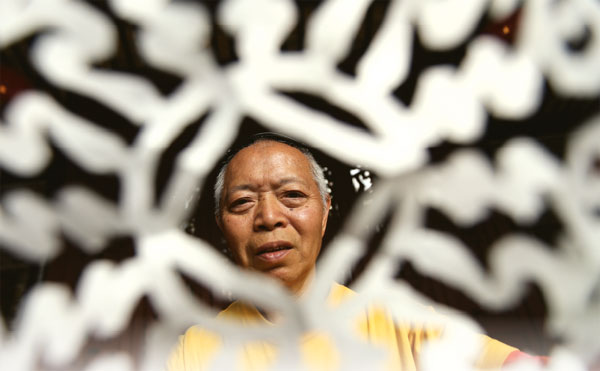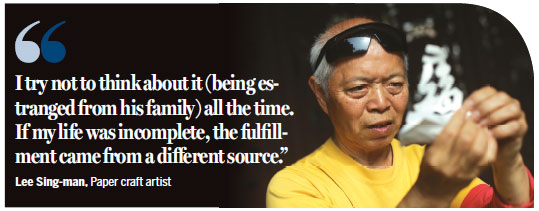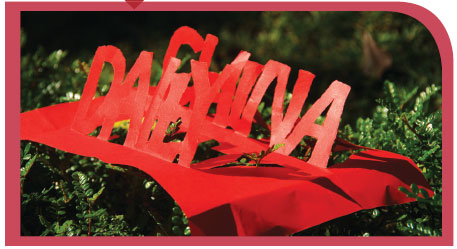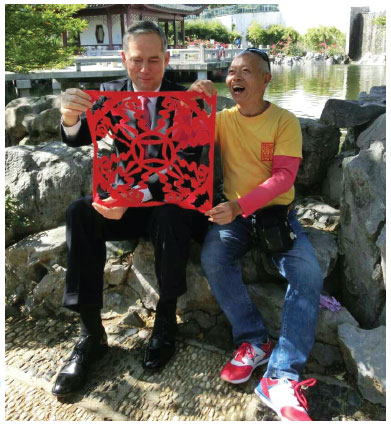Tearing up the past
Updated: 2015-03-09 07:43
By Evelyn Yu(HK Edition)
|
|||||||||
When Lee Sing-man lost both his home and family, it seemed there was nothing worth living for. A renewed engagement with the traditional Chinese folk art of paper tearing brought him back from the brink. Evelyn Yu reports.
On a gusty Wednesday morning in January, under a sunny sky, Lee Sing-man, 74, better known as "Uncle Man", was back at his usual place in Kowloon Walled City Park. The spot was very close to where Lee came back from the brink of death and rediscovered himself, 15 years ago.
He stood there, smiling, with a piece of colorful paper, folded into eight sections, in his hand. Suddenly animated, Lee's fingers began moving swiftly over the paper, tearing out a zig-zag shape, then shifting to the corner; the center shaping a triangle. Something quite resembling a bird wing emerged.
In a trice, Lee was finished. He unfolded the paper to reveal eight characters of "Fook", the Chinese characters meaning happiness, four bats, and a Chinese coin - a traditional Chinese pattern depicting happiness and prosperity. Lee, a master of the art of paper tearing, has performed this magic before heads of state and their ladies.
Fifteen years ago his life seemed torn to bits. So there he was, standing on the ledge of his apartment building, ready to jump from the 25th floor. His wife had left him, taking their teenage daughter. He couldn't afford to pay off the mortgage on his own, so the bank foreclosed.
It's hard to imagine why, on the brink of death, he suddenly recalled the words of his former brother-in-law, complimenting him on his paper tearing skills - acknowledging Lee's mastery of "spatial concepts". His brother-in-law was a professor who thought about things like spatial concepts. And he did not offer compliments easily.
The memory of that incident made Lee stop and withdrew his foot from the brink. He had rediscovered his self-esteem.
Lee has no official capacity in Kowloon Walled City Park but he shows up there every day, promptly after morning tea: in his red T-shirt and worn blue jeans, waiting for someone who might be looking a little lost - someone who could do with a little help from a volunteer guide.
On his belt is a rather peculiar array - camera, flute and a bag in which he carries papers of different sizes and colors.
Accidental artist
Until Lee stepped into the limelight as a master of paper craft, he was a courier for 26 years. For a good part of that time he carried the consignments in his bare hands and got around on shank's mare.
Once he had to carry a window frame as big as himself, and once he had to pick up a cinerary basket from a funeral parlor. It was all in a day's work.
Bored and with nothing to do on Lunar New Year's Eve in 1983, Lee took a leftover red Spring Couplet paper, carefully extracting the words "Big Luck" out of it.
It was another six years before he gave it another try, goaded by a friend. His friends were amazed and proclaimed him a genius - pressing him to produce more wondrous creations and he did not disappoint them.
His reputation grew. People in the government recognized his work and he was invited to demonstrate his skills for visiting dignitaries. Once, aboard a cruise ship rebuilt from a vintage Star Ferry, he performed for the president and first lady of Romania. One member of the boat's crew confided that the austere first lady had betrayed a delighted smile when she saw Lee's magic, before resuming her composure.
After the bank foreclosed on his apartment, Lee moved into a cramped apartment five minutes' walk from Kowloon Walled City Park. To get rid of his negative feelings he started tearing paper, somewhat obsessively.
He used any paper he could find, table mat papers from McDonald's, discarded newspapers. He tore out his works of art, even as he was waiting for the lift or riding the subway. Over time he grew more ambitious, going from tearing out simple blessings to any characters, both in Chinese and English, creating compact pieces combining words, animal figures, profile silhouettes produced on small squares of paper, which take on three-dimensional shapes when unfolded.
"Paper tearing saved my life," Uncle Man said.
He cannot remember when he stopped being the regular Lee and came to be known as "Uncle Man" to his young friends.
"I was out walking in the neighborhood when a kid I didn't seem to know from before who was also there with his parents suddenly called out, 'Uncle Man'. His parents felt strange and asked, 'Do you know him?' The kid replied, 'Yes! He taught us tearing paper.'"
He loves demonstrating his art to wide-eyed tourists, being invited to perform in front of large crowds at carnivals. It has given his life meaning.
Lost forever
His estranged family ought to know of his new-found fame, as he has performed on television many times.
He still hopes for a reunion with them. He has in fact publicly appealed to his lost loved ones to contact him. A picture of his daughter was posted in a newspaper, hoping she might be reunited with her father. There was no response. Uncle Man regrets allowing his daughter's photo to go public. "She might hate me for posting her photo," he said.
"She might already be married and raising her own child," Uncle Man surmised. He hasn't had a single piece of information about them since the day they left in 2000.
He admits that if his family wanted to see him, they could have contacted him by now.
He is circumspect in the face of reporters' questions about his former wife.
"Maybe my daughter did not come to me because she worried that will annoy her mother," he continued. "But I always think that I might have seen my daughter, standing among a flock of spectators, watching me tearing paper," Uncle Man said in a deep voice.
"I try not to think about it all the time. If my life was incomplete, the fulfillment came from a different source," he said.
Fame did not bring his lost love back, or shelter him with stable income.
The folk artist lives on Comprehensive Social Security Assistance. Income from his paper tearing is insignificant. He never put a price tag on his creations. Customers pay what they want, 10 or 20 HK dollars. In most cases he gives away his work free.
He never quotes a fee for the public performances he gives. "The organizers have their own budget. I will take whatever they give me".
In the roughly 10-square-meter apartment he lives in, paper works, trophy cups awarded for being an outstanding social worker and living necessities pile up the cramped bedroom, in which the toilet is squarely opposite the single bed.
The sneakers he wears were picked up from a rubbish bin. Some kindhearted people gave him clean, used garments to wear. He's happy with his life as it is now.
Contact the writer at evelyn@chinadailyhk.com


|
Lee Sing-man manipulates a piece of red paper to create a three-dimensional replica of China Daily. Evelyn yu / China Daily |
|
Lee Sing-man poses with US Consul-General to Hong Kong Clifford Hart after demonstrating his craft to him in Kowloon Walled City Park. roy liu / China Daily |

(HK Edition 03/09/2015 page7)

